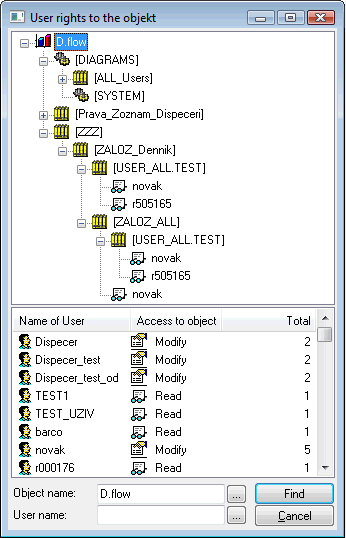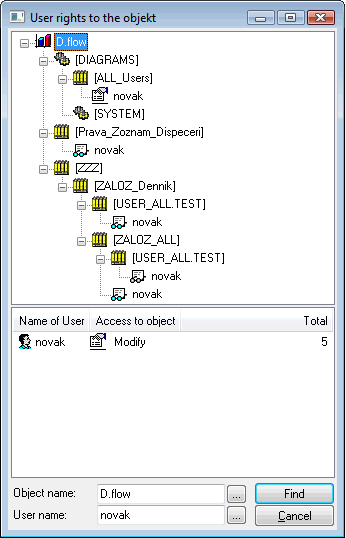...
- No access (the highest priority)
- Modify
- Control
- Read (the lowest priority)
Warning:
If the user is an administrator, there is no reason to search his access rights to the objects because the administrator can always modify all the D2000 objects except the objects of User type. These objects can be modified only by the administrators with the right to modify the objects of User type. Otherwise, the user has only the right to read.
...
A dialog window is accessible from popup menu in the selection window in D2000 CNF => Extended actions => User Access Rights.
Meaning of hierarchical structure:
- Several groups of objects (ALL_Users, EDIT.GRAF, Home_novak, ...) with the some access rights are assigned to user (novak). These rights apply to the objects belonging to these groups but not to the group.
- If access rights also apply to the members of group or children of object the name of this object is in square brackets ([USER_S01.ZTI_RIS], [B.PREMIUM_CPU]).
- If access rights also apply to the members of group ([USER_S01.ZTI_RIS]) there is a nesting of a tree structure and listing of the members belonging to the group.
- If access rights also apply to the children of object ([DIAGRAMS]) there is a nesting of a tree structure and listing of these children providing there is searching the specific object. The nesting ends at this object (see the second picture - D.flow is nested through a parent object [DIAGRAMS]).
Groups of objects and rights
| Name of Group | The name of object groups. |
| Access to objects | Describes the rights to object belonging to some group. |
| Access to group | Describes the rights to group of objects. |
| Total | Defines a total occurrence of the group in structure. |
Filtering
The lower part of the dialog serves to determine the user's access rights to a specific object.
| User name | The currently selected user. It can be changed by direct editing or by clicking the "..." button. |
| Object name | Selection of the object whose access rights we want to find out - by direct editing or by clicking on the "..." button |
| Find | Finding access rights. |
The following figure shows that the SystemD2000 user has read access to the I/O tag M.Machine_States, which is included in the Home_s object group, both directly and through the B.test station with its children.
| Kotva | ||||
|---|---|---|---|---|
|
...
The dialog window is accessible from the popup menu in the selection window - an item User rights to the object.
Meaning of hierarchical structure:
- It is a backward hierarchy, from the object (D.flow) to individual users with defined access rights.
- The user is searched only through the groups with members or through the objects with children.
- A branch representing the parents of object is visible too (it is the only branch that need not to end with user).
- At the end of hierarchy there is the user with access rights to the object (access rights are represented by proper icon).
...
Groups of objects and rights
| Name of User | Name of user. |
| Access to object | Describes the user's rights to object. |
| Total | Defines a total occurrence of user in structure. |
Filtering
The lower part of the dialog serves to determine the user's access rights to a specific object.
| Object name | The currently selected object whose access rights we want to find out - by direct editing or by clicking on the "..." button |
| User name | Selection of the user. It can be changed by direct editing or by clicking the "..." button. |
| Find | Finding access rights. |
The following figure shows that the SystemD2000 user has read access to the I/O tag M.Machine_States, which is included in the Home_s object group, both directly and through the B.test station with its children.
| Info | ||
|---|---|---|
| ||









